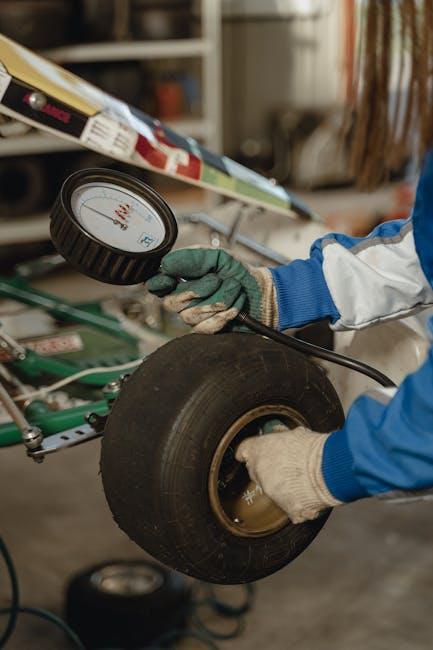Picture yourself gliding smoothly around a bend, the world outside your window shifting ever so slightly as your car leans gently into the turn. This subtle tilt, often unnoticed yet profoundly felt, is more than just a quirk of motion—it’s a complex dance of physics and engineering at play. Why does your car lean when turning? Understanding this natural inclination reveals insights into the forces acting on your vehicle, the design choices made by manufacturers, and how these factors combine to keep you safe and comfortable on the road. In this article, we’ll explore the reasons behind that familiar lean, decoding the invisible dynamics that shape every turn you take.
Table of Contents
- Understanding the Physics Behind Car Leaning in Turns
- Common Suspension Issues That Cause Excessive Body Roll
- How Tire Pressure and Alignment Affect Vehicle Stability
- The Role of Weight Distribution in Cornering Performance
- Maintenance Tips to Minimize Car Lean and Enhance Safety
- Upgrading Your Suspension System for a Smoother Drive
- Q&A
- Wrapping Up

Understanding the Physics Behind Car Leaning in Turns
When a car takes a sharp turn, the sensation of leaning is primarily due to centrifugal force. As the vehicle changes direction, this force pushes outward, trying to pull the car away from the curve. The car’s suspension system resists this force, but the balance is delicate. The result? The entire body tilts, or “leans,” toward the outside of the turn, creating that familiar sideways sway that drivers both feel and see. This lean is not arbitrary—it’s physics in motion, explaining why you feel pushed to one side of the seat during cornering.
Several factors contribute to how pronounced this lean appears:
- Center of Gravity: A higher center of gravity means more noticeable leaning.
- Suspension Design: Stiff suspensions reduce lean but can decrease comfort.
- Speed and Turn Radius: The faster or sharper the turn, the greater the lateral forces involved.
| Factor | Effect on Car Lean |
|---|---|
| High Center of Gravity | More Lean |
| Soft Suspension | Increased Body Roll |
| Tight Turn at High Speed | Maximum Lean |

Common Suspension Issues That Cause Excessive Body Roll
Excessive leaning during turns often traces back to worn or malfunctioning components within the suspension system. A common culprit is aged shocks or struts, which lose their damping ability over time, allowing the car’s body to sway more noticeably. Similarly, weak or broken anti-roll bars (sway bars) can lead to inadequate resistance against lateral forces, causing that unsettling lean. Additionally, loose or damaged bushings reduce stability by allowing excessive movement between suspension parts, further contributing to body roll.
Another overlooked source is uneven or worn tire treads, which can unbalance grip during turns and exacerbate leaning. Here’s a quick glance at key suspension elements that often cause excessive roll:
- Shock absorbers/struts: Reduced damping performance
- Anti-roll bar links: Broken or worn connections
- Control arm bushings: Loose or degraded cushioning
- Springs: Sagging or uneven coil wear
| Component | Common Issue | Effect on Body Roll |
|---|---|---|
| Shock Absorbers | Fluid leakage, wear | Excessive swaying |
| Anti-Roll Bar | Broken links | Reduced lateral resistance |
| Control Arm Bushings | Cracked, loose | Instability during turns |
| Coil Springs | Sagging, uneven wear | Unequal body support |

How Tire Pressure and Alignment Affect Vehicle Stability
Maintaining the appropriate tire pressure is crucial for the way your vehicle responds during a turn. Unequal or incorrect inflation causes uneven tire contact with the road, which directly impacts traction and balance. For instance, underinflated tires flex more and generate additional heat, decreasing grip and making the car feel unstable. Overinflated tires, conversely, reduce the contact patch, resulting in less traction and an increased likelihood to lean excessively on corners. Ensuring tires are inflated to manufacturer-recommended levels promotes even wear and delivers the steady response needed for smooth, controlled turns.
Alignment plays an equally pivotal role in vehicle stability by affecting how each wheel tracks the road. Misaligned wheels, for example, can lead to uneven tire wear and unintended pulling or drifting when cornering. Proper alignment ensures that all wheels are pointed in the ideal direction, distributing forces evenly and minimizing body roll. Below is a simple table summarizing the common alignment issues and their influence on vehicle stability:
| Alignment Issue | Impact on Stability |
|---|---|
| Toe Misalignment | Causes tires to scrub, reducing grip and increasing lean |
| Camber Issues | Uneven tire contact, causing instability and excessive leaning |
| Incorrect Caster | Reduces steering stability and cornering precision |
- Proper tire pressure and alignment work together to keep your vehicle balanced.
- Ignoring these factors accelerates tire wear and compromises handling.
- Regular checks are essential to maintain optimal vehicle responsiveness during turns.

The Role of Weight Distribution in Cornering Performance
When a vehicle takes a corner, its weight shifts dynamically from one side to the other. This redistribution isn’t random; it dramatically influences how the tires grip the road and how the car responds to steering inputs. A balanced weight distribution, often close to a 50/50 front-to-rear ratio, helps maintain stability and predictability during turns. When the weight shifts excessively to the outer wheels, it causes the car to lean or roll — a natural reaction as the suspension compresses under the increased load. This weight transfer affects not only comfort but also safety and handling precision.
Key factors influenced by weight distribution include:
- Tire grip: More weight on a tire generally increases its traction up to a point, but uneven distribution can lead to uneven tire wear.
- Body roll: Excessive leaning is often a sign that the suspension and weight balance are not optimized for aggressive cornering.
- Understeer and oversteer tendencies: The balance of forces created by weight shift can either push the car wide (understeer) or cause the rear end to slide out (oversteer).
| Weight Distribution | Common Handling Effect | Ideal Cornering Result |
|---|---|---|
| 50/50 Balanced | Neutral handling, even grip | Stable, predictable turns |
| Front-heavy | Understeer | Car resists turning, pushes wide |
| Rear-heavy | Oversteer | Rear slides, requiring correction |

Maintenance Tips to Minimize Car Lean and Enhance Safety
Proper maintenance is crucial to ensure your vehicle handles corners smoothly and safely. Start by regularly checking your suspension components—worn-out shocks or struts reduce your car’s ability to resist lean forces when turning. Keeping your suspension in top shape means your car will hug curves better, maintaining stability and control. Additionally, regularly inspect and maintain the alignment of your wheels. Misaligned wheels cause uneven tire wear and increased body roll, which not only accelerates lean but also compromises overall vehicle safety.
Another essential factor is tire care. Consistent tire pressure and tread depth provide optimal grip, reducing unwanted sway during turns. Pay attention to tire rotation schedules to promote even wear, and replace tires promptly when tread levels drop below safe limits. Implementing these practices can significantly reduce your car’s tendency to lean, creating a safer and more comfortable driving experience for you and your passengers.
- Regular Suspension Inspections: Detect and replace damaged components early.
- Wheel Alignment Checks: Maintain correct angles for optimal handling.
- Tire Pressure Monitoring: Keep tires inflated to manufacturer’s recommendations.
- Tire Rotation: Promote even tire wear and performance.
- Timely Tire Replacement: Ensure maximum traction and safety.
| Maintenance Item | Check Frequency | Effect on Lean |
|---|---|---|
| Shock Absorbers | Every 12,000 miles | Reduces body roll |
| Wheel Alignment | Every 10,000 miles | Prevents uneven lean |
| Tire Pressure | Monthly | Improves grip and stability |
| Tire Rotation | Every 6,000 miles | Ensures balanced wear |

Upgrading Your Suspension System for a Smoother Drive
Enhancing your car’s suspension system is a transformative step toward achieving that coveted smooth drive, especially when navigating curves or uneven roads. A well-tuned suspension not only dampens the harsh impacts from bumps but also significantly reduces the tendency of your vehicle to lean excessively during turns. Upgrading components such as performance shocks, stiffer sway bars, and upgraded springs can drastically improve your car’s stability and cornering precision. These modifications work together to keep your tires firmly planted on the road, mitigating roll and fostering better weight distribution.
Before diving into upgrades, consider this quick comparison of popular suspension upgrades:
| Component | Primary Benefit | Ideal For |
|---|---|---|
| Performance Shocks | Enhanced damping control | Everyday driving with improved comfort |
| Stiffer Sway Bars | Reduced body roll | Dynamic cornering on twisty roads |
| Upgraded Springs | Better ride height and response | Sportier handling with sharper turns |
By thoughtfully selecting and upgrading these parts, you’re not just improving suspension—you’re redefining the connection between your car and the road, making each journey feel confident and controlled.
Q&A
Q&A: Why Does Your Car Lean When Turning?
Q1: What exactly causes a car to lean or tilt when turning?
A1: When your car turns, centrifugal force pushes it outward from the center of the curve. This force acts on the car’s center of gravity, causing the body to lean opposite the direction of the turn. Essentially, the car “leans” because the suspension and tires work to balance these forces, but the vehicle’s weight shifts, creating that noticeable tilt.
Q2: Is car leaning a sign of a problem or just normal behavior?
A2: A certain amount of lean is completely normal and expected. It’s a natural response to the physics of turning and helps drivers sense the limits of their vehicle’s grip. However, excessive leaning might indicate worn suspension components, improper tire pressure, or an uneven load distribution, which could affect handling and safety.
Q3: Does the design of the car affect how much it leans in turns?
A3: Absolutely! Sports cars with low centers of gravity and stiff suspensions lean less, delivering sharp and stable cornering. Conversely, taller vehicles like SUVs and trucks, with higher centers of gravity and softer suspensions, tend to lean more. The way a car is engineered plays a big role in how it handles lateral forces during turns.
Q4: Can you reduce or prevent your car from leaning too much in corners?
A4: You can minimize excessive lean by maintaining your suspension system—checking shocks, struts, and bushings regularly. Upgrading to performance springs or anti-roll bars can also stiffen the suspension, reducing body roll. Additionally, slowing down before turns helps decrease the forces causing the lean, making your ride smoother and safer.
Q5: Is car lean beneficial or detrimental to driving?
A5: Lean isn’t inherently bad; it actually provides feedback and improves grip by allowing weight transfer to the outside tires, enhancing traction. That said, too much lean compromises stability and control, potentially leading to understeer or oversteer. The ideal balance is firm enough to maintain composure, yet flexible enough to communicate road conditions to the driver.
Q6: How does car lean relate to safety in everyday driving?
A6: Understanding lean helps drivers anticipate how their vehicle behaves around corners, especially at higher speeds or in emergency maneuvers. Maintaining your suspension and tires ensures your car responds predictably, reducing rollover risk and improving overall control. So, a little lean is a natural part of driving—just make sure it’s not excessive.
Wrapping Up
In the dance between physics and engineering, your car’s lean during a turn is a subtle yet telling performance. It’s a reminder of the forces at play beneath the surface—the balance of speed, weight, and suspension working together to keep you grounded, even as you glide through curves. Understanding why your car leans not only deepens your appreciation for its design but also empowers you to drive with greater confidence and control. So next time you feel that lean, remember: it’s your car’s way of adapting, balancing the thrill of the turn with the science of safety.
